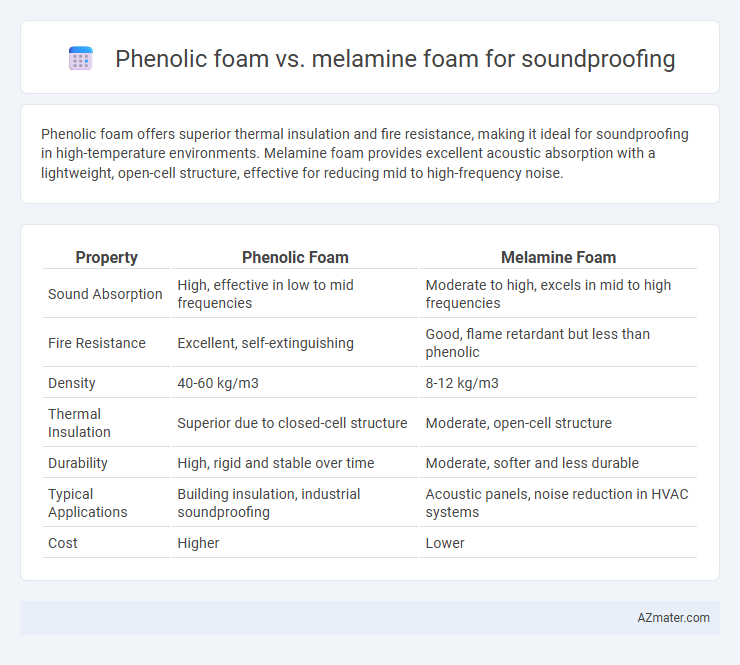Phenolic foam offers superior thermal insulation and fire resistance, making it ideal for soundproofing in high-temperature environments. Melamine foam provides excellent acoustic absorption with a lightweight, open-cell structure, effective for reducing mid to high-frequency noise.
Table of Comparison
| Property | Phenolic Foam | Melamine Foam |
|---|---|---|
| Sound Absorption | High, effective in low to mid frequencies | Moderate to high, excels in mid to high frequencies |
| Fire Resistance | Excellent, self-extinguishing | Good, flame retardant but less than phenolic |
| Density | 40-60 kg/m3 | 8-12 kg/m3 |
| Thermal Insulation | Superior due to closed-cell structure | Moderate, open-cell structure |
| Durability | High, rigid and stable over time | Moderate, softer and less durable |
| Typical Applications | Building insulation, industrial soundproofing | Acoustic panels, noise reduction in HVAC systems |
| Cost | Higher | Lower |
Introduction to Phenolic Foam and Melamine Foam
Phenolic foam, known for its rigid cellular structure and high fire resistance, excels in thermal insulation and sound absorption within industrial and commercial applications. Melamine foam features an open-cell structure with excellent noise reduction and soundproofing properties, making it ideal for acoustics in studios, offices, and vehicles. Both materials provide effective soundproofing, but phenolic foam offers superior fire safety while melamine foam delivers enhanced acoustic dampening and lightweight flexibility.
Composition and Physical Properties
Phenolic foam consists of a rigid polymeric structure formed from phenol-formaldehyde resin, offering low density, high thermal resistance, and excellent flame-retardant properties, making it effective for thermal and acoustic insulation. Melamine foam is an open-cell polymer made from melamine-formaldehyde resin, recognized for its lightweight, flexible texture, and strong sound absorption due to its porous nature, which enhances noise reduction in soundproofing applications. The denser, rigid structure of phenolic foam provides better insulation and structural support, while melamine foam's porous, lightweight composition excels in absorbing airborne sound waves.
Soundproofing Performance Comparison
Phenolic foam offers superior soundproofing performance due to its closed-cell structure, providing high-density insulation and excellent noise absorption across a broad frequency range. Melamine foam, while lighter and more flexible, excels at absorbing mid to high-frequency sounds but is less effective at blocking low-frequency noise compared to phenolic foam. For environments requiring maximum sound isolation, phenolic foam delivers better acoustic attenuation and thermal stability, making it the preferred choice for industrial and commercial applications.
Fire Resistance and Safety
Phenolic foam offers superior fire resistance due to its low flame spread and smoke generation, making it an ideal choice for soundproofing applications requiring stringent fire safety standards. Melamine foam, while effective in sound absorption, is more flammable and produces toxic smoke when exposed to high heat, posing safety risks in fire-prone environments. Choosing phenolic foam enhances overall safety in buildings by reducing fire hazards without compromising acoustic performance.
Thermal Insulation Capabilities
Phenolic foam provides superior thermal insulation due to its closed-cell structure and low thermal conductivity, typically around 0.020 W/m*K, making it highly effective in reducing heat transfer alongside soundproofing. Melamine foam, while excellent for acoustic absorption, has higher thermal conductivity values, generally near 0.035 W/m*K, resulting in less effective thermal insulation performance compared to phenolic foam. Choosing phenolic foam ensures better combined soundproofing and thermal insulation for environments requiring energy efficiency and noise control.
Durability and Longevity
Phenolic foam offers superior durability and longevity in soundproofing applications due to its rigid cellular structure and high resistance to heat, moisture, and chemical degradation. Melamine foam, while excellent for sound absorption and fire resistance, tends to be less durable over time as it is more prone to physical wear and compression under pressure. For long-lasting soundproofing solutions, phenolic foam is generally preferred for environments requiring sustained performance and structural integrity.
Installation and Application Methods
Phenolic foam offers straightforward installation with rigid panels that can be easily cut and fitted into wall cavities or ceilings, making it ideal for large-scale commercial soundproofing projects. Melamine foam, known for its lightweight and flexible structure, is typically applied as sheets or blocks directly onto surfaces or within acoustic panels, providing versatility in irregular spaces and customized applications. Both materials require minimal additional tools, but phenolic foam's rigid form demands precise measurements, whereas melamine foam allows quicker adjustments during installation.
Environmental Impact and Sustainability
Phenolic foam offers superior fire resistance and higher thermal insulation but is derived from petrochemical sources, raising concerns about its environmental footprint. Melamine foam, made primarily from melamine resin, is more biodegradable and recyclable, making it a more sustainable choice for eco-conscious soundproofing applications. Both materials vary in toxicity during production and disposal, with melamine foam generally presenting fewer environmental hazards.
Cost Analysis and Value for Money
Phenolic foam typically offers a lower upfront cost compared to melamine foam, making it a budget-friendly option for large-scale soundproofing projects. Melamine foam, while more expensive, provides superior acoustic absorption and fire resistance, delivering better long-term value for environments requiring stringent safety standards. Evaluating cost against performance, phenolic foam suits cost-sensitive applications, whereas melamine foam justifies its premium through enhanced durability and effectiveness.
Best Use Cases and Recommendations
Phenolic foam excels in high-temperature environments and offers superior fire resistance, making it ideal for industrial soundproofing applications and HVAC insulation. Melamine foam provides excellent sound absorption and lightweight properties, suitable for acoustic treatments in residential and commercial spaces. For environments requiring flame retardancy and thermal insulation, phenolic foam is recommended, while melamine foam is best for enhancing room acoustics and reducing noise reverberation.

Infographic: Phenolic foam vs Melamine foam for Soundproofing
 azmater.com
azmater.com